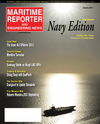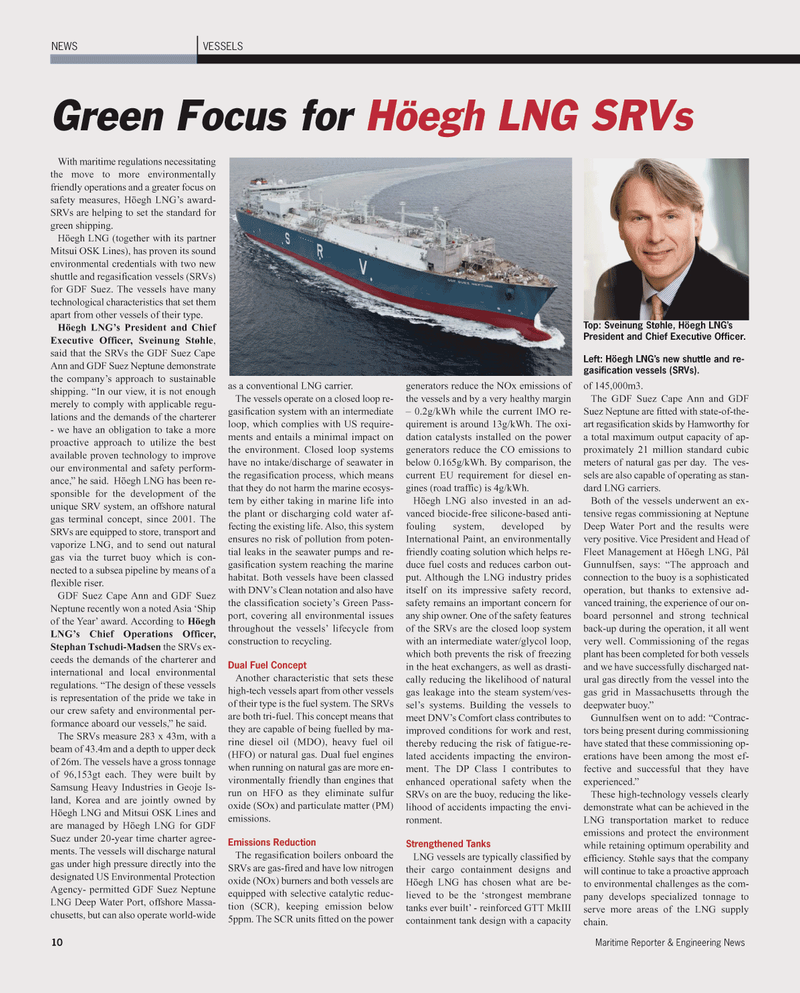
Page 10: of Maritime Reporter Magazine (January 2011)
International Naval Technology
Read this page in Pdf, Flash or Html5 edition of January 2011 Maritime Reporter Magazine
10 Maritime Reporter & Engineering News
With maritime regulations necessitating the move to more environmentally friendly operations and a greater focus on safety measures, Höegh LNG’s award-
SRVs are helping to set the standard for green shipping.
Höegh LNG (together with its partner
Mitsui OSK Lines), has proven its sound environmental credentials with two new shuttle and regasification vessels (SRVs) for GDF Suez. The vessels have many technological characteristics that set them apart from other vessels of their type.
Höegh LNG’s President and Chief
Executive Officer, Sveinung Støhle, said that the SRVs the GDF Suez Cape
Ann and GDF Suez Neptune demonstrate the company’s approach to sustainable shipping. “In our view, it is not enough merely to comply with applicable regu- lations and the demands of the charterer - we have an obligation to take a more proactive approach to utilize the best available proven technology to improve our environmental and safety perform- ance,” he said. Höegh LNG has been re- sponsible for the development of the unique SRV system, an offshore natural gas terminal concept, since 2001. The
SRVs are equipped to store, transport and vaporize LNG, and to send out natural gas via the turret buoy which is con- nected to a subsea pipeline by means of a flexible riser.
GDF Suez Cape Ann and GDF Suez
Neptune recently won a noted Asia ‘Ship of the Year’ award. According to Höegh
LNG’s Chief Operations Officer,
Stephan Tschudi-Madsen the SRVs ex- ceeds the demands of the charterer and international and local environmental regulations. “The design of these vessels is representation of the pride we take in our crew safety and environmental per- formance aboard our vessels,” he said.
The SRVs measure 283 x 43m, with a beam of 43.4m and a depth to upper deck of 26m. The vessels have a gross tonnage of 96,153gt each. They were built by
Samsung Heavy Industries in Geoje Is- land, Korea and are jointly owned by
Höegh LNG and Mitsui OSK Lines and are managed by Höegh LNG for GDF
Suez under 20-year time charter agree- ments. The vessels will discharge natural gas under high pressure directly into the designated US Environmental Protection
Agency- permitted GDF Suez Neptune
LNG Deep Water Port, offshore Massa- chusetts, but can also operate world-wide as a conventional LNG carrier.
The vessels operate on a closed loop re- gasification system with an intermediate loop, which complies with US require- ments and entails a minimal impact on the environment. Closed loop systems have no intake/discharge of seawater in the regasification process, which means that they do not harm the marine ecosys- tem by either taking in marine life into the plant or discharging cold water af- fecting the existing life. Also, this system ensures no risk of pollution from poten- tial leaks in the seawater pumps and re- gasification system reaching the marine habitat. Both vessels have been classed with DNV’s Clean notation and also have the classification society’s Green Pass- port, covering all environmental issues throughout the vessels’ lifecycle from construction to recycling.
Dual Fuel Concept
Another characteristic that sets these high-tech vessels apart from other vessels of their type is the fuel system. The SRVs are both tri-fuel. This concept means that they are capable of being fuelled by ma- rine diesel oil (MDO), heavy fuel oil (HFO) or natural gas. Dual fuel engines when running on natural gas are more en- vironmentally friendly than engines that run on HFO as they eliminate sulfur oxide (SOx) and particulate matter (PM) emissions.
Emissions Reduction
The regasification boilers onboard the
SRVs are gas-fired and have low nitrogen oxide (NOx) burners and both vessels are equipped with selective catalytic reduc- tion (SCR), keeping emission below 5ppm. The SCR units fitted on the power generators reduce the NOx emissions of the vessels and by a very healthy margin – 0.2g/kWh while the current IMO re- quirement is around 13g/kWh. The oxi- dation catalysts installed on the power generators reduce the CO emissions to below 0.165g/kWh. By comparison, the current EU requirement for diesel en- gines (road traffic) is 4g/kWh.
Höegh LNG also invested in an ad- vanced biocide-free silicone-based anti- fouling system, developed by
International Paint, an environmentally friendly coating solution which helps re- duce fuel costs and reduces carbon out- put. Although the LNG industry prides itself on its impressive safety record, safety remains an important concern for any ship owner. One of the safety features of the SRVs are the closed loop system with an intermediate water/glycol loop, which both prevents the risk of freezing in the heat exchangers, as well as drasti- cally reducing the likelihood of natural gas leakage into the steam system/ves- sel’s systems. Building the vessels to meet DNV’s Comfort class contributes to improved conditions for work and rest, thereby reducing the risk of fatigue-re- lated accidents impacting the environ- ment. The DP Class I contributes to enhanced operational safety when the
SRVs on are the buoy, reducing the like- lihood of accidents impacting the envi- ronment.
Strengthened Tanks
LNG vessels are typically classified by their cargo containment designs and
Höegh LNG has chosen what are be- lieved to be the ‘strongest membrane tanks ever built’ - reinforced GTT MkIII containment tank design with a capacity of 145,000m3.
The GDF Suez Cape Ann and GDF
Suez Neptune are fitted with state-of-the- art regasification skids by Hamworthy for a total maximum output capacity of ap- proximately 21 million standard cubic meters of natural gas per day. The ves- sels are also capable of operating as stan- dard LNG carriers.
Both of the vessels underwent an ex- tensive regas commissioning at Neptune
Deep Water Port and the results were very positive. Vice President and Head of
Fleet Management at Höegh LNG, Pål
Gunnulfsen, says: “The approach and connection to the buoy is a sophisticated operation, but thanks to extensive ad- vanced training, the experience of our on- board personnel and strong technical back-up during the operation, it all went very well. Commissioning of the regas plant has been completed for both vessels and we have successfully discharged nat- ural gas directly from the vessel into the gas grid in Massachusetts through the deepwater buoy.”
Gunnulfsen went on to add: “Contrac- tors being present during commissioning have stated that these commissioning op- erations have been among the most ef- fective and successful that they have experienced.”
These high-technology vessels clearly demonstrate what can be achieved in the
LNG transportation market to reduce emissions and protect the environment while retaining optimum operability and efficiency. Støhle says that the company will continue to take a proactive approach to environmental challenges as the com- pany develops specialized tonnage to serve more areas of the LNG supply chain.
NEWS VESSELS
Green Focus for Höegh LNG SRVs
Top: Sveinung Støhle, Höegh LNG’s
President and Chief Executive Officer.
Left: Höegh LNG’s new shuttle and re- gasification vessels (SRVs).

 9
9

 11
11
